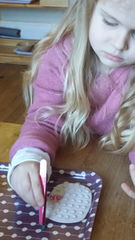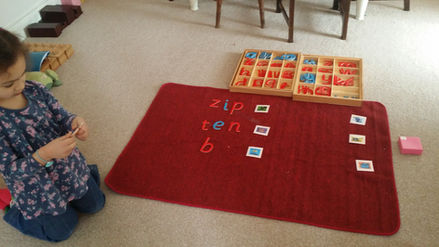top of page

About Montessori
The Montessori Method is a method of teaching, but not in the conventional method of a constant flow of information from teacher to child, regardless of the child being motivated to learn at that moment.
The Montessori teacher is more of a facilitator and children can move about and use specialised equipment that has been designed to encompass all five senses for the child's holistic development. The Montessori Method teaches concepts in a concrete form and then the child is gradually direct towards an abstract way of thinking. They will suddenly realise that they know the answer already and won't need the equipment any more. The transition to abstract thinking will have been made.
The Montessori equipment is divided between the seven subject areas of Mathematics, Sensorial (including some early maths), Literacy, Cultural, Creative, Gross motor and Practical Life, with some overlap between the subject areas.
Within each subject area, the younger child is introduced to an activity, and when the child accomplishes it, a slightly more complex activity is introduced. Children are free to choose when they want to do an activity, what they want to do and how they want to do it (within reason!). They are also free to do nothing!
The philosophy behind this is that a child will instinctively know what they want/need to do and are ready to learn and will be enabled to grow in concentration and ability by not being disturbed at their work.
The older children need to work through each area of the curriculum but are able to do this at their own pace and order.
We find that a child will often start the day with a simple task that they know they can achieve, to build their confidence and then push themselves by tackling a more difficult one.
In the Practical Life area the activities are based on real-life activities, such as hammering, threading and pouring. This encourages children towards independence and therefore potential to grow in confidence and self-esteem. These activities also give practice in fine motor control, such as pincer grip and gross motor control, such as balance.
The Sensorial equipment is designed to stimulate all the senses: smell, touch, taste, sight and sound. Individual activities stimulate an isolated sense without the distraction of other stimuli which can lead to the diminishment of an experience. Mathematical concepts, such as breadth and length are introduced here.
Literacy is taken in stages. We introduce children to pre-literacy games, such as I-spy to introduce them to the initial sounds of words. We then use sandpaper letters and objects to learn to write the sounds and the children practice writing the letters in a sand tray, leading to reading and writing with a pen. It is a phonetic way of learning to read. Sight reading is then introduced alongside.
In Mathematics we introduce children to sorting and matching games and then move on to sandpaper numerals and children being able to associate a particular number of objects with a numeral. Further concepts are introduced as a child is ready.
We use as many natural products as possible and encourage a love of nature and the environment in children. In the Cultural area, the children learn about the globe, planets and then continents, countries and then their locality. They learn about life-cycles, geographical land forms, the water-cycle and time through timelines, as well as other concepts.
Creativity is a big part of the children's work at Cam Valley. Children are introduced to types of artwork, crafts, singing, music poetry, stories and movement such as artwork, singing and movement.
Some people are concerned that if a child is given so much freedom at this young age that they will not be able to conform to school life, where there is much more institutionalisation. The converse however is true! The more freedom a child is given at this stage in their development (within clear boundaries), the more they will have their needs met and the less dysfunctional they will be, enabling them to be flexible and able to conform at their next stage of development (around 7 years old), and able to adapt with greater ease to situations in later life.
bottom of page
































